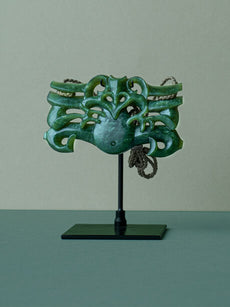Your cart is empty
Keep ShoppingJade, greenstone or pounamu
Nephrite jade is known by many names including jade, greenstone and pounamu. Geologists most commonly use the term nephrite jade, while Māori refer to their treasured stone as pounamu. New Zealand’s early European settlers called it greenstone - a name that is still used today and thought to have stood the test of time for its ease of remembrance. To everyone else, the stone is simply known as jade. You’ll find that we use all of these names interchangeably across our website and everything we carve is nephrite jade.

The origins of pounamu
Nephrite jade is found in many parts of the world, but in New Zealand it can only be found in the South Island, mainly on the West Coast – which is why the island is named Te Waipounamu, which translates to “the waters of greenstone”. There are two stories of the origin of pounamu, one being Māori legend and the tale of a taniwha named Poutini - the guardian of pounamu. The second being the story of mother nature, and her incredible power.
Pounamu the legend
One day, as he rested in the northern seas of the Bay of Plenty, Poutini watched a beautiful young woman named Waitaiki come down to the water to bathe. Enchanted by her beauty, Poutini captured Waitaiki and fled south with his treasure - lighting fires along the way to keep her warm. Waitaiki’s husband, the powerful chief Tamaahua, soon discovered his loss and furiously paddled his canoe in pursuit of his love and her captor. He followed closely, and found precious stones amidst the remains of Poutini's fires.
The chase was relentless, and Poutini finally stopped on the West Coast of the South Island, hiding up the Arahura River. Not wanting to give her up, he knew the only way to keep Waitaiki for forever, was to turn her into his own essence. So Poutini transformed Waitaiki into pounamu and lay her in the river bed. He quietly escaped past Tamaahua, and is thought to have ever since swam up and down the West Coast guarding the land and its precious pounamu.
This legend gives the West Coast its name Te Tai o Poutini – “the tides of Poutini”.

A gift from Mother Earth
Science tells us the origin of pounamu starts with mother earth and that the stone is a metamorphic rock formed deep in the earths crust, under intense heat and pressure, 200-300 million years ago. As tectonic plate movement slowly forged the Southern Alps, uplifting stresses moved nephrite bearing lenses upwards to the surface of the mountains. Here the lenses were worn down by the elements, and jade was slowly exposed from its softer enclosing rocks. For much of the past two million years, the rising Southern Alps were buried under huge ice glaciers. As glacial movements occurred, pounamu was slowly forced down the valleys. Landslides, erosion and rivers also scattered fragments over wide areas. Pounamu today can be found on our mountains, in our rivers and in the sea.

A world of jade
Jade is found in many spectacular locations around the world and each country has its own unique and beautiful variation. We source our jade from the wilds of Canada, Siberia, Australia, America, China, Indonesia, Australia and our own back yard – New Zealand. The minerals that are present in the earth where the stone is formed give jade its colour and texture. Australia is famed for its black jade, Siberia for its pale green almost white stone, China for its vibrant green base with black speckled dots, and New Zealand for its unique flower jade with hues of yellow and gold.

We’ve made it our company mission to source out the best stones from every corner of the world, and learn as much as we can from the jade experts that we meet on our travels. Three generations of the Sheehan family, the founders of Mountain Jade, have been driven to achieve this mission which has so far been carried out over 35 years - and we now have one of the largest jade collections to show for it! You can learn more about the different types of jade we carve below.








































Follow Us
Stay in the know on new releases, special offers, and more.